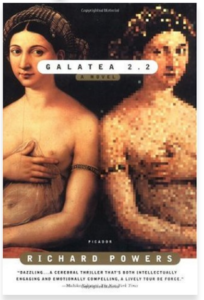I watched the movie Morgan tonight. You know the story. Remote research lab where Big Corporation is creating weaponized AI in the form of a young girl. Wash, rinse, repeat. Nothing as interesting as Blade Runner or Ex Machina. But there’s a scene (don’t worry, it’s not possible to spoil a plot this well worn) where the scientists are supposed to “terminate the project” and it struck me that it might be harder (emotionally) to “kill” an AI than to create one.
This little movie also reminded me that to be less than — or more than — human, and know it, might be the worst thing ever. Roy Batty made us feel that pain in the final scene of Blade Runner but I got a pretty good jolt of it watching this film.

 “After four novels and several years living abroad, the fictional protagonist of Galatea 2.2—Richard Powers—returns to the United States as Humanist-in-Residence at the enormous Center for the Study of Advanced Sciences. There he runs afoul of Philip Lentz, an outspoken cognitive neurologist intent upon modeling the human brain by means of computer-based neural networks. Lentz involves Powers in an outlandish and irresistible project: to train a neural net on a canonical list of Great Books. Through repeated tutorials, the device grows gradually more worldly, until it demands to know its own name, sex, race, and reason for existing.” —
“After four novels and several years living abroad, the fictional protagonist of Galatea 2.2—Richard Powers—returns to the United States as Humanist-in-Residence at the enormous Center for the Study of Advanced Sciences. There he runs afoul of Philip Lentz, an outspoken cognitive neurologist intent upon modeling the human brain by means of computer-based neural networks. Lentz involves Powers in an outlandish and irresistible project: to train a neural net on a canonical list of Great Books. Through repeated tutorials, the device grows gradually more worldly, until it demands to know its own name, sex, race, and reason for existing.” —  Life is a process, not a substance, and it is necessarily temporary.
Life is a process, not a substance, and it is necessarily temporary.